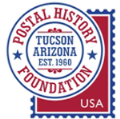
Hazards of early Arizona mail delivery
Paintings by Cal Peters
The paintings
Each painting depicts issues involving mail delivery in Territorial Arizona. We invite you to consider not only the artistry, but also the stories. From whose perspective are these stories told? What values are placed on the various cultures living in Arizona? Who is the hero, who is the villain, and why?

Buckboard mail
There is one recorded account of this man, “Mr. Leonard,” being shot at near the “Nine Mile Water Hole,” which was located neat the junction of the Santa Cruz and Rillito Rivers. Picacho Peak can be seen in the background. Supposedly, Mr. Leonard, with iron bolts (used as bullets) embedded in his skin, continued on to Tucson and delivered the mail.

Dragoon Pass ambush
Captain Gerald Russell (hand in the air), also known as “Old Jerry,” was a career military man stationed at Ft. Bowie. Part of Russell’s job was to patrol the Dragoon Mountains and protect settlers from Cochise and his band. There is no mention in any of his reports of finding a dead mail carrier, although it would not have been unusual; he reports four “Actions with Indians” in 1871 that saw six native people wounded, one cavalry member wounded, one civilian wounded, and one civilian killed.

Pack Mule Mail
Mules are more surefooted and hardy than horses and were often preferred to horses as mail carriers. The mail line most famous for using mules in the Yuma area was the San Antonio-San Diego Mail Line. The San Antonio-San Diego Mail Line was the first of its kind, blazing a trail for the more famous “Butterfield” Overland Mail Company that would soon use the same route.

Fairbank train robbery
Fairbank (no “s” at the end), with its train depot, Butterfield stagecoach station, Wells Fargo office, quartz mill, saloon, general store, and other services, was an important way point between Tucson and Tombstone in the late 1800s and early 1900s. The Alford-Stiles gang, covertly run by lawmen Burt Alvord and Billy Stiles, planned to rob the Wells Fargo Express car at dusk on February 15, 1900. Famously tough Wells Fargo Express Agent Jeff Milton managed to thwart the robbery even while critically wounded. Milton shot “Three-Fingered” Jack Dunlap in the gut; he died later from his wounds. “Bravo Juan” Tom Yoas was hit in the backside and escaped. Stiles and Alvord were later captured. Milton nearly lost his arm. He continued as an express agent and retired to Tucson in 1942.

Wickenburg murder mystery
The attack on the stage just outside of Wickenburg, Arizona, in 1871 was a real historical event and caused a national outrage. Six people were mercilessly slaughtered. However, it is by no means certain that Native Americans were responsible for the attack. Although some of the remaining Yavapai were punished, evidence also points to Mexican robbers living in Hassayampa Canyon, white Americans wanting to stir up more anti-native feelings so as to restart the “Indian Wars,” and even one of the two survivors, William Kruger, is thought to have had a hand in the murders. One of the most odd aspects to this attack is that, in most accounts, nothing was stolen, not even the horses. The Wickenburg murders of 1871 are one of Arizona’s most enduring mysteries.


















































